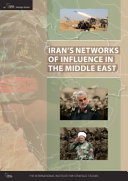Book Review: Iran’s Networks of Influence in the Middle East
The International Institute for Strategic Studies is an independent research, information, and center of research on issues related to conflicts that may or may not be heavily armed. The Institute’s staff is international in composition, and IISS’s work is international in perspective and reach. The Institute makes all of the decisions about what to do on its own because it is independent. It has no ties to any political party, association of governments, or other entity. The IISS places a strong emphasis on conducting thorough, fact-based research with a view toward the future.
An esteemed international institute of strategic studies in Eastern geopolitics, the author of “Iran’s Network of Influence in the Middle East” focuses especially on Iran’s regional strategies and the workings of its network of influence. The IISS contributes a comprehensive grasp of the difficulties of Iran’s foreign policy objectives and its relations with diverse parties in the Middle East, drawing on both his education in political science and his extensive research experience in the field. The IISS’s earlier writings have explored related subjects in depth and provided perceptive evaluations of Iran’s regional objectives and interactions with proxy organizations around the region.
Book Introduction: In “Iran’s Network of Influence in the Middle East,” the writer offers a thorough analysis of Iran’s diverse strategies for influencing the area. The book clarifies Iran’s strategic goals, its use of proxy militias and sub-state actors, and the consequences of its actions for regional peace and global security through meticulous research and astute analysis. The book instigates questions on Tehran’s ability to fight by, with, and through third parties in foreign jurisdictions, which has become a valuable and effective sovereign capability that gives Iran a strategic advantage in the region. Tehran has possessed a form of this capability since the Islamic Revolution in 1979, but its potency and significance have risen sharply in the past decade, to the point where it has brought Iran more regional influence and status than either its nuclear or ballistic-missile programs.
Review of Chapters: The book “Iran’s Network of Influence in the Middle East” is divided into six chapters, each of which provides a thorough examination of different aspects of Iran’s network of influence. The author sets out the historical information and ideological underpinnings of Iran’s regional strategy in the first two chapters. These chapters provide information that is essential to understanding Iran’s Middle East strategies and goals.
In the subsequent chapters (3-5), the author delves into Iran’s specific engagements in key countries such as Iraq, Syria, and Yemen. The book examines Iran’s role in these conflicts, its support for proxy groups, and its broader geopolitical goals in every scenario through in-depth case studies and analysis. It has a major influence—verging on a controlling influence in some cases—over the affairs of Syria, Lebanon, Iraq, and Yemen. The fact that Iran has stealthily built up a network of non-state alliances right across the Middle East, often referred to as “proxy militias” is nothing new. Starting with Hezbollah in Lebanon, the Islamic Republic has been seeking to export its revolutionary ideology and expand its influence beyond its borders ever since the return of Ayatollah Ruhollah Khomeini to Tehran in 1979.But the 217-page report by the IISS, entitled “Iran’s Networks of Influence in the Middle East,” provides unprecedented detail on the extent and reach of Iran’s operations in the region.
In Chapter 6, which is the last chapter of the book, the prospective future paths of Iran’s network of influence are reviewed, and the opportunities and difficulties they pose for regional players and the global community are assessed.
Book Map: The book’s maps and visuals, which enhance the reader’s understanding of Iran’s network of influence, are an important aspect. For instance, a map showing the geographic range of militias and proxy organizations supported by Iran offers important context for understanding the scope of Iran’s influence in the region.
Critical Analysis: Although the book provides an in-depth analysis of Iran’s network of influence, there are various areas in which the author could have delved deeper or offered more complex perspectives. To enhance the analysis, further research should be done on the socioeconomic variables that influence Iran’s support for proxy organizations and how its actions affect the local population.
Recommendations: “Iran’s Network of Influence in the Middle East” is a must-read for scholars, policymakers, and anybody else curious about the intricate details of Middle Eastern geopolitics. It is an invaluable resource for learning about Iran’s regional strategies and how they affect international security because of its rigorous study, perceptive analysis, and clear presentation.
Overall, “Iran’s Network of Influence in the Middle East” offers a compelling exploration of a complex and timely topic, shedding light on one of the most significant geopolitical dynamics shaping the Middle East today.
Ufraa Ashraf is a student of Strategic Studies at National Defense University, Islamabad, Pakistan. Her research interests include the regional security studies, civil military relations, cybersecurity and geopolitics.



Comments are closed.